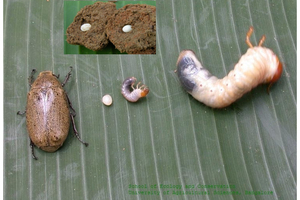The white grub is not a species of pest in and of itself, but is the name for the larval stage of various types of beetle, including Japanese beetles, june bugs, and chafers. It is in the larval stage that these pests can be the biggest threat to your garden, as they attack the roots of plants.
Grubs usually are not too much of an issue for flowers and vegetables, due to the fact that their roots are far apart and flower beds are dug up often. Grass, on the other hand, is much more vulnerable to white grubs because grass roots are so close together. Grubs kill grass from the bottom up.
Conventional lawn pesticides tend not to have much effect on grubs, though they can help by killing the adults of the species before they lay eggs. There are special pesticides, however, designed to soak into the soil that can be quite effective at getting at the grubs. These include Merit (imidacloprid) and Mach-2 (halofenozide).
But it’s very possible to avoid using such chemicals at all for the control of lawn grubs. For one thing, there’s a good chance no treatment is really necessary. As mentioned, there’s unlikely to be a white grub problem in a flower or vegetable garden. But it’s really not that common a problem even for grass lawns, though people trying to sell you pesticides might attempt to persuade you otherwise. A Cornell University study conducted in an unusually bad year for grub infestations found that even then only 18% of lawns had a grub problem bad enough to warrant treatment.
So the first thing you need to do is make sure there even is a grub issue worth treating. For signs of lawn grub infestation, look for irregular patches of dead or dying yellow or brown grass in your lawn. Due to root damage, the grass will lift out of the ground easily if you pull on it. The ground may feel soft or spongy.
If this leads you to suspect grubs, peel back one square foot of lawn and check for the little white wormlike grubs. The rule of thumb is if you see eight or more, you have a serious enough infestation to treat. If you see zero to four, don’t bother. If you see five to seven, that’s in a gray area where it’s not a bad idea to treat, but it’s not imperative to do so. What you may want to do in that case is sample one or more additional one foot squares to see if they bring the average over seven or under five.
But even if treatment is necessary, there is an organic alternative to using chemical pesticides.
The best organic method for dealing with white grubs is by way of their natural predators. Certain parasitic wasps, ants, and ground beetles kill grubs and/or the eggs they hatch from. (Which is one reason against spraying pesticides on your lawn. You typically end up killing more beneficial than harmful insects.)
But you can also buy and apply one of the grub’s natural predators-parasitic nematodes. Nematodes are very tiny worms. Some are good for plants; some are quite harmful. The kind that are parasitic on grubs are highly beneficial to plants in that they kill off the larvae eating their roots.
Follow the instructions that come with the package of nematodes carefully. For one thing, you’ll need to thoroughly water the area of the lawn to be treated, as this enables the nematodes to swim along with the water as it seeps into the soil where they can find white grubs.
White grubs can be addressed-through pesticides or organically through parasitic nematodes-any time of year, however some times are recommended over others based on the life cycle of the grubs. Ideally you’ll want to get them when they’re small, and when they’re closest to the surface. White grubs are smallest from about mid-July through September, and they tend to be closest to the surface during that time and then in March and April. So the best time to treat your lawn is the second half of the summer, and the second best time is March and April.
Sources:
Doug Green, “Organic Grub Control.” Doug Green’s Simplegiftsfarm.
Arzeena Hamir, “Controlling Lawn Grubs Organically.” Garden Guides.
White Grubs: Control of White Grub Infestations in Lawns.” Pest Products.
